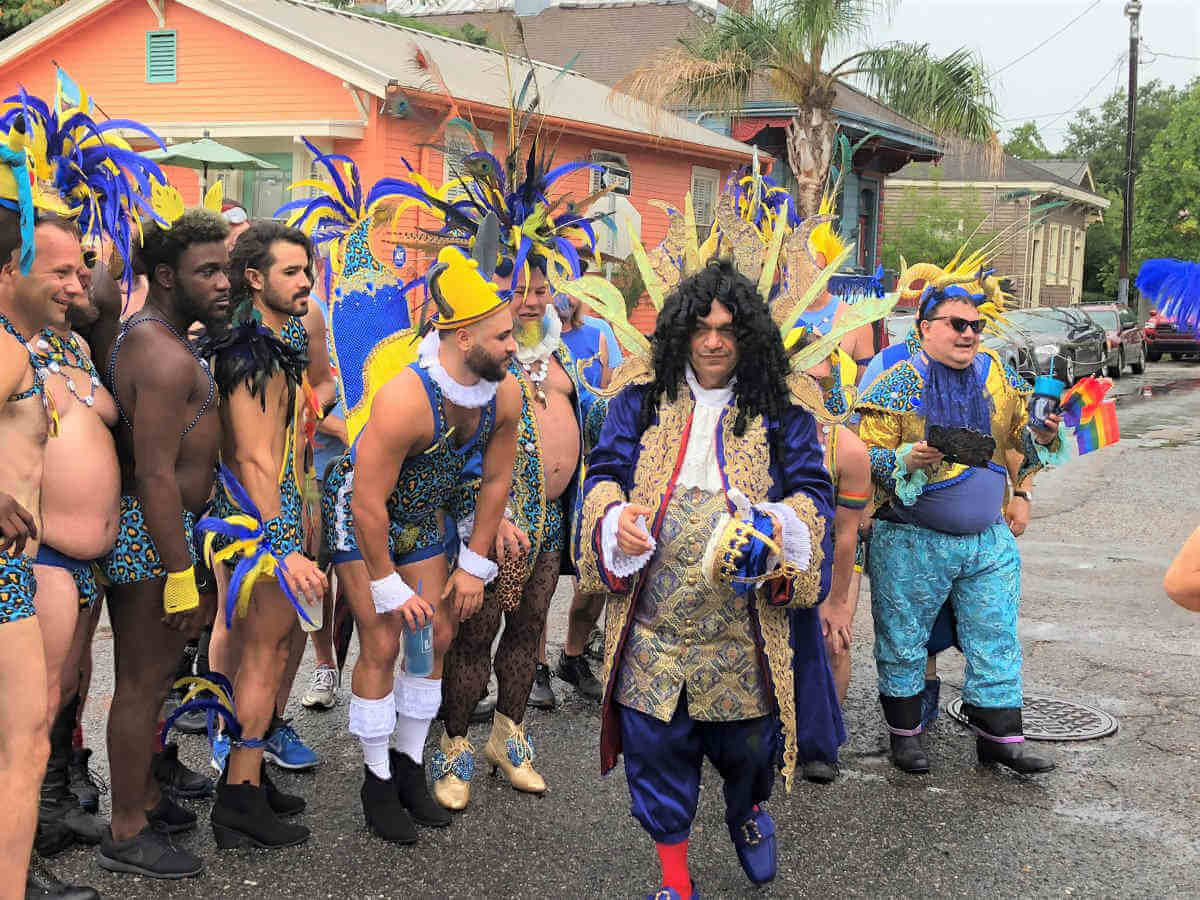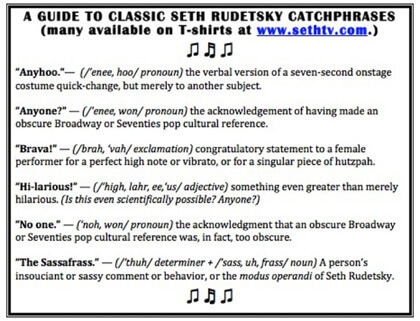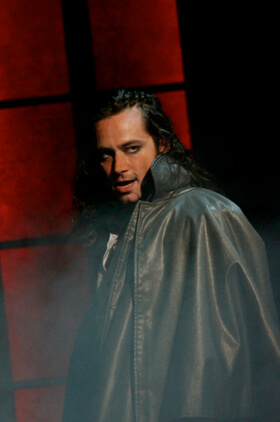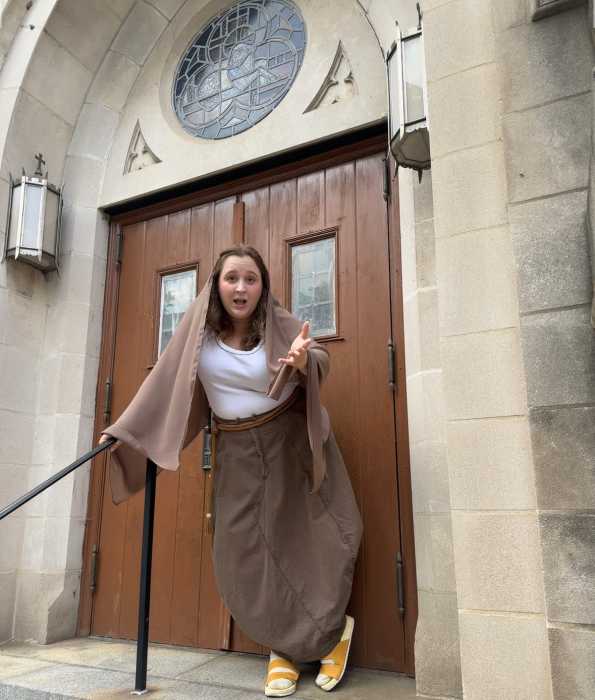Frank Perez, bewigged and dressed as King Louis XIV, gave a brief but pointed history lesson to the crowd gathered outside the Golden Lantern bar in New Orleans’ French Quarter: “Forty-six years ago, when we had the first Southern Decadence, the city was still arresting us. Now they’re fucking toasting us!”
Perez, one of two grand marshals of Southern Decadence 2018, spoke from a stage to kick off the Grand Marshal Walking Parade, the festival’s oldest event, held on the Sunday before Labor Day. His comment referred to the 1970s, when police were raiding gay bars in the French Quarter, arresting and often abusing patrons. The cops also busted anyone appearing in public in full drag. There even had been earlier attempts by conservative neighborhood preservationists to drive gay men and lesbians from the French Quarter. But as Perez’s profane remark attested, things have changed. The Sun King of this year’s Southern Decadence received a proclamation from the office of Mayor LaToya Cantrell recognizing the significance of the festival and honoring him, his co-grand marshal Adikus Sulpizi, and all the previous grand marshals.
New Orleans hardly could ignore Southern Decadence. The annual event, most of whose activities occur over the Labor Day weekend, is now the city’s third-largest festival, after Mardi Gras and JazzFest. This year it generated $275 million in revenue, attracting about 235,000 attendees from around the world. Revelers had a dizzying array of Decadence-related activities to choose from — the Bourbon Street Extravaganza, a free outdoor concert featuring disco divas; the Dykeadence dance party for lesbians; HARD|soft, a black women-centric fetish ball; Mr. Louisiana Leather, presented by the gay male Carnival “krewe” the Lords of Leather; drag brunches; hotel pool parties; bar parties featuring porn stars; and events presented by out-of-town party promoters, like the “bear”-oriented Bearracuda Atlanta and Furball NYC, Horsemeat Disco, and Daniel Nardicio’s “Bette, Bathhouse and Beyond,” a recreation of a 1970s Bette Midler show at the Continental Baths.
Only the Grand Marshal Walking Parade is deemed an “official” Southern Decadence event; its roots are in the festival’s origins. The other oldest event, the Bourbon Street Extravaganza hosted by Chuck Robinson, owner of the Napoleon’s Itch bar, has been a Southern Decadence standby for 14 years. This year’s show featured gay circuit party favorites Jeanie Tracy, who started out as one of Sylvester’s backup vocalists; R&B singer and actress Deborah Cox; and Jennifer Holliday, who, two days before, sang at Aretha Franklin’s funeral.
As Robinson told me, “Nobody owns Southern Decadence, just like nobody owns Easter or Halloween or Christmas. Everybody does their own thing and it all just comes together.”
Gay men are the majority of Southern Decadence attendees, and the festival is popularly known as “gay Mardi Gras.” In the lobby of our hotel, I overheard a desk clerk say to another employee, “Must be Southern Decadence, all the gay guys are in town.” “And God bless ‘em,” his co-worker replied. As Perez noted, the business is “a very welcome thing, especially since it’s usually slow for the service sector in the South during the summer.”
During Decadence, gay men seem ubiquitous, in the crowds packing the French Quarter’s gay bars and streets, in restaurants and at popular tourist attractions like Café Du Monde in the French Market and Jackson Square near the Mississippi riverfront. Like other tourists, they peruse and shop in the art and antique stores on Royal Street; the difference is that they’re more likely to do so in fetish wear, like the six-foot-plus, bearded and tattooed man in a leather jockstrap and harness I saw peering at the art prints in a shop window.
But Southern Decadence actually did not begin as a gay event. This annual extravaganza has much humbler origins, as a house party and bar crawl. Its founders were a mixed group of men and women, gay and straight, black and white, who partied at a house in the Tremé neighborhood, near the French Quarter. The house, owned by a gay couple, David Randolph and Michael Evers, was a rundown structure they and their friends dubbed Belle Rêve, after the DuBois family plantation in Tennessee Williams’ “A Streetcar Named Desire.” They were a literary and bohemian bunch who had been English or film studies majors in college and, in 1972, on one of New Orleans’ oppressively hot and humid late summer weekends, they held a party, inviting guests to come dressed as their favorite “Southern decadent” characters from literature.
Two weeks later, the Belle Rêvers held a going-away party for Randolph and Evers, who were temporarily relocating to Michigan.
In 1973, there was another party, but it began with a meetup at a local bar, with revelers then parading back to Belle Rêve. That bar was Matassa’s, a now-defunct establishment on Dauphine Street owned by Giovanni “Johnny” Matassa, a Sicilian immigrant whose late son, Cosimo, is a beloved cultural figure in New Orleans because of his role in recording much of the classic rhythm and blues and rock ‘n roll records of the 1950s and 1960s.
In the early 1970s, New Orleans bars were segregated, by race, gender, and sexuality. “If you were black, you didn’t go to a white bar and a white person didn’t go to a black bar,” said Perez. “Straight bars didn’t want gays, the gay bars didn’t want lesbians, the lesbian bars didn’t want the gays. But Matassa’s didn’t care about your color or orientation.” The Belle Rêvers met at Matassa’s, “got tanked up, and then walked the 15 or so blocks back to the house,” stopping at other watering holes on the way. “That was the first parade,” said Perez, “although they wouldn’t have called it that. It really was more of a bar crawl.”
In 1974, the core Belle Rêve group got bigger ideas; they decided to make the bar crawl a true parade. A parade would need a grand marshal, so the Belle Rêvers selected one of their group, Frederick Douglass Wright, a gay black man. Wright, said Perez, was a brilliant academic who went on to become a dean at Notre Dame University. He also was a hard-partying man who eagerly embraced his role as Southern Decadence’s first grand marshal.
In “Southern Decadence in New Orleans,” a history of the festival by Perez and historian Howard Philips Smith published this year, the authors note that by 1975, “Southern Decadence had become much anticipated not only among the Belle Rêvers… but among other locals, both gay and straight, although it remained very much an underground affair restricted to those in the know.”
By 1981, Perez said, what had grown from a bar crawl into a parade started getting gayer and began its route at the Golden Lantern, its kickoff point ever since.
“This year the parade is bigger than it’s ever been, with more than 100 groups and some 1,500 people marching,” he added. “I would say that most of the people who come to town for Southern Decadence don’t even know that there is a parade. But that’s what the core of Southern decadence is, the parade.”
Although the Grand Marshal Walking Parade has a permit from the city and police protection, it remains, in Perez’s description, “a loosey-goosey affair.” The grand marshals, he said, have “sole discretion” to select their successors.
“We have to raise anywhere from $10,000 to $12,000 just to produce the parade,” according to Perez. “That’s paying for the parade permits and for the security details, sanitation, parade insurance, as well as all the expenses that go into hosting dozens of small fundraisers throughout the summer. Whatever is left over is given to charity.” The charities the grand marshals selected this year were Team Friendly, an HIV organization with which Sulpizi is associated, and the LGBT+ Archives Project of Louisiana, which Perez heads.
The theme of this year’s parade was “House of Bourbon: Unleash Your Beast,” an allusion to the 300th anniversary of New Orleans’ founding by colonists from Bourbon dynasty-ruled France. Perez and his entourage were dressed like 18th century Bourbons, while Sulpizi and his coterie of Manimals were costumed as sexy beasts, with bare chests and butts, horns, and tails.
“We were founded by this depraved line of kings who had every vice known to humanity, rivaling anything from ancient Rome,” Perez remarked. “‘Unleash Your Beast’ is an attempt to try to put the decadence back in Southern Decadence. There are some people who think Decadence should be sanitized or more corporate. Fuck that!”
But with Southern Decadence’s growth into a major festival, some institutionalization was inevitable. A fiscal scandal in 2012 — one of the grand marshals absconded with money from the fundraising events — led to the formation of a nonprofit organization to manage the festival’s money and provide financial accountability.
Frank Perez, born in Baton Rouge to a Cuban immigrant father and a mother from New Orleans, spent much of his childhood in the city. He lives in an airy apartment on St. Ann Street, in the heart of the French Quarter, and is an historian not only of Southern Decadence but also of New Orleans’ LGBTQ communities. On the Thursday before Southern Decadence weekend, he went to the historic Beauregard-Keyes House on Chartres Street to give a talk to members of the Vieux Carré Property Owners and Residents Association, founded in the 1920s to promote the “preservation, restoration, beautification and general betterment” of the French Quarter. Perez’s lecture filled the large hall in the old mansion, the audience comprising mostly older white people.
“There’s a certain liberty in the French Quarter today but it wasn’t always that way for gay people,” Perez told his listeners. “There have been gays and lesbians and transgender people here since the city’s founding. But in the 1950s, it was a very dangerous time to be gay in New Orleans.” As French Quarter tourism took off during that decade, some feared that the growing and visible presence of gay people would deter straight visitors. “There was a concentrated effort by politicians to suppress the gay community in New Orleans,” Perez said. “Police raids [of gay establishments] were very common.”
In 1958, the owners of one frequently-raided bar, Tony Bacino’s, sued the city. They lost the case, but their lawsuit, said Perez, “was the first attempt at gay activism in New Orleans.” That year, a young gay man named Fernando Rios was murdered by three undergraduates from Tulane University who had gone to the French Quarter to “roll a queer,” which Perez mordantly called “a very popular recreational sport in the 1950s for straight kids.” Rios’ assailants were acquitted after a trial in which their lawyers presented a “gay panic” defense, falsely claiming that Rios had propositioned one of the undergrads.
That same year, at the urging of neighborhood preservationists and political and religious conservatives, the New Orleans City Council formed the Committee on the Problem of Sex Deviance. In a report, the committee recommended that New Orleans adopt “a climate of hostility towards homosexuals.” Bar raids, street arrests, and other harassment were the concrete manifestations of that official hostility. Fifteen years later, the horrific arson attack on the UpStairs Lounge, which resulted in the deaths of 32 patrons, brutally reminded the city’s gay population of their despised status. Parents refused to claim the burnt bodies of their children, churches denied funerals to victims, and local media condemned the bar and its patrons, with one writer suggesting that the victims be buried “in fruit jars.”
“I find this climate of hostility, this very homophobic attitude, somewhat ironic,” Perez told his audience, noting that gay men, such as the philanthropist William Ratcliffe Irby and the writer Lyle Saxon, were influential champions of French Quarter preservation. “You might not have a French Quarter today if it were not for gay men who were preservationists,” he said.
Every year since 1977, religious conservatives have protested at Southern Decadence, descending on the French Quarter with signs and using bullhorns to blare chants condemning homosexuality. They returned this year, a group of a dozen or so grim-faced, mostly middle-aged white men who kept popping up at various locations over the weekend. They positioned themselves outside gay bars and picketed the Grand Marshals Walking on Sunday. Most people ignored them; others mocked them; some confronted them, like the very angry, muscular gay black man who got in the face of one protester and floridly cursed him. The protester looked like he was living his worst nightmare.
Outside Café Lafitte in Exile, we encountered several young, inebriated straight women who had been taunting the protesters. “I hate that they do this to you guys,” one said. “I’m from here, I grew up on these streets, and I never feel as safe as I do when Decadence is happening.” Another woman, noting the “No Porn” button on the shirt of one protestor, told him, “Why don’t you just go home and rub one out? You’ll feel a lot better.”
We first encountered the protesters as they stood on a sidewalk along the parade route. Then, when we reached North Rampart Street, they appeared again. They actually were allowed to fall in at the end of the parade (though not too closely), following us and bullhorn-blasting chants about “homos.” As the parade dispersed, so did they; we didn’t run into them again.
The protests used to be led by Reverend Grant Storms, a preacher from Metairie who, in 2003, marched with his followers on Southern Decadence with bullhorns. Storms also made a videotape purporting to show gay “orgies” occurring in public during the festival. It actually depicted one man with bared buttocks; another wearing a G-string, inside a gay strip club; and one man on his knees in front of two men on Bourbon Street. Storms sent the video to a right-wing Republican legislator who drafted a bill that would increase penalties for public sex, which already was illegal in Louisiana. The bill passed the state House of Representatives on a 102-1 vote, subsequently passed the State Senate, and was signed into law by the governor.
In 2011, however, the crusading Reverend Storms was arrested for masturbating in his car in a public park. He was subsequently convicted of obscenity and sentenced to three months’ probation.
Storms no longer leads the anti-Southern Decadence protests, and my efforts to find out who now does were unsuccessful. The protesters’ banners didn’t identify a church or sponsoring organization. Past protests were linked to stree
The mayor’s office and the New Orleans Police Department did not respond to my inquiries about the protesters and the director of the city’s Human Relations Commission, in the mayor’s office, could not identify them. None of these officials responded to my questions about city policy toward the protests or why the police permitted the protesters to harass Southern Decadence attendees.
Vincenzo Pasquantonio, a gay man who directs the Human Relations Commission, told me that the city is “trying to strike a balance between our safety and allowing people to exercise their First Amendment rights, and that is an ongoing process that we’re always seeking to improve.”
That blandly bureaucratic response, however, ignores the fact that in 2004, French Quarter business owners obtained a restraining order against Storms and his followers, and the City Council voted to bar the use of bullhorns during Decadence. Moreover, police repeatedly have arrested protesters, for violating the bullhorn ordinance and for assaulting police and Southern Decadence attendees, in 2016 and last year. Yet this year, the police allowed the bullhorns and made no attempt to keep protesters from the Southern Decadence crowds.
“The Christian Nazis are a perennial problem — every Mardi Gras, every Southern Decadence,” Frank Perez told me. “I don’t know why the city can’t keep them under control.”
The Grand Marshal Walking Parade was a delight, a colorful, often outrageous celebration that showcased not only the city’s LGBTQ community but also the bohemianism from which Southern Decadence sprang. There were the Rolling Elvi (various Elvis impersonators), a flag-waving contingent, a Vladimir Putin dance troupe, fetish groups like Louisiana Pups and Handlers, a gay male rugby team, too many drag queens to count, and dance groups, like the Nyxettes, the Camel Toe Steppers, Baby Dolls, Merry Antoinettes, and Organ Grinders.
The story of Southern Decadence is how a house party and bar crawl among a small group of friends, gay and straight, grew into New Orleans’ third largest festival. Its success represents the increased acceptance and political and economic clout of New Orleans’ LGBT Qcommunity while also embodying the city’s vaunted let-the-good-times-roll ethos and its Carnival traditions. Southern Decadence’s demographics have changed, too, with the greater involvement of people of color in festival events.
But New Orleans’ image as “the city that care forgot” and as a mecca for LGBTQ people, nonconformists, and rebels of all kinds belies the fact that it suffers from great social and racial disparities, with inadequate housing, violent crime, joblessness, poor public schools (the city has become a living laboratory for school privatization), and a longstanding tradition of corruption and brutality among its police force. New Orleans has yet to fully recover from the devastation of Hurricane Katrina in 2005.
In “Desire and Disaster in New Orleans: Tourism, Race, and Historical Memory,” New Orleans author Lynnell L. Thomas criticizes the city for cultivating tourism “at the expense of other economic and commercial development.”
The “touristic culture,” she writes, transformed the city, with New Orleans’s economic, political, and social institutions becoming “dependent on and defined by the tourism industry” rather than “by a conception of the public good or social justice for the city’s poorest and most marginal residents.”
New Orleanians recognize the economic importance of tourism and, being generally warm and gregarious, welcome tourists. But their patience has limits. Some visitors forget that the French Quarter isn’t only an entertainment district but also a neighborhood, and one with problems. Tourism, notwithstanding the revenue it generates, is one, and it’s not just the bad behavior of some out-of-towners. Tourism has helped fuel the gentrification and speculation that have transformed the formerly working- and middle-class area, with escalating housing costs pushing out lower-income people and African Americans. Many of the beautiful antebellum townhouses have been subdivided into expensive condominiums that are vacant most of the year. Gentrification has spread to other areas, like Tremé and Bywater.
Tourists coming to New Orleans for Southern Decadence, or for JazzFest, Mardi Gras, Essence Music, or any of the smaller festivals held throughout the year, might do well to remember that although this unique, irreplaceable, and troubled city is a place to play, it is not just their playground.




































